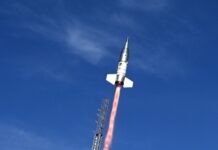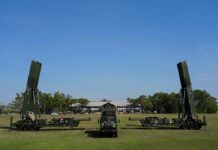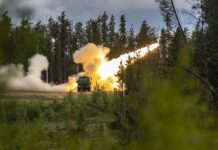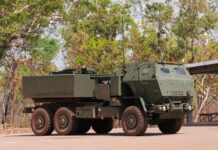Lockheed Martin continues to make progress with ramping up its missile production in light of increased demand due to hostilities in Ukraine and the Middle East and US allies’ need to boost their weapon inventories.
Speaking on 13 October at the 2025 Association of the US Army (AUSA) Exposition in Washington, DC, Paula Hartley, vice president and general manager for tactical missiles at Lockheed Martin’s Missile & Fire Control business, stated, “If you take a look at where we’re going to be at the end of 2025 compared to 2024 we have increased production output by almost 50%.”
Hartley noted that the company’s High Mobility Artillery Rocket System has already doubled its production output and the Javelin anti-armour missile is on its way to doubling production output.
With regard to Guided Multiple Launch Rocket System (GMLRS) round production, Hartley said, “Two years ago we were at about 8,000 a year; right now we’re building 14,000 a year, and we’ve been doing that for about a month now.”
Hartley said Lockheed Martin was “surging production at the speed of need across all of our munitions and all the launchers that accompany those”.
Explaining how the company had done that, Hartley pointed to additional second sources and the use of technologies like robotics and additive manufacturing, while getting GMLRS to 14,000 rounds per year also involved adding in a second shift into the production line.
Jason Reynolds, Lockheed Martin’s vice president and general manager for integrated air and missile defence, told a similar story. With regard to the Patriot air defence system’s PAC-3 missiles, Reynolds said that “over the last few years, PAC-3 went from 300 missiles per year to 350, to 500, to 550; we’re going to produce over 600 this year, and we’re on a path under contract to get to 650 and beyond”.
With regard to Lockheed Martin’s Terminal High Altitude Area Defense (THAAD) system, Reynolds said that, while the company currently produces just under 100 missiles per year, “we’re tooled for about a 50% increase on that” using capabilities such as robotics and additive manufacturing.
“We’re not a new kid on the block,” said Reynolds. “We know how to build things that work the first time, every time, all the time, and when we do that we also know how to take that to scale. And so working with our global supply chain, most but not all of our products for the PAC-3 [missile] have second sources. We’re working to make that more resilient.
“THAAD, on the other hand, doesn’t have a lot of second sources,” Reynolds explained. “It was designed by the US Missile Defense Agency, and it basically has limited second sources, but we’re now partnering with them to look at what we can do to increase supply. And when we talk about global supply chain, we mean just that. We’re looking at suppliers, both domestically and internationally, those that can help our strengthen our relationship home and abroad, as well as give us the needed capability and capacity that we’re looking for.”
Regarding Lockheed Martin’s missile global supply chain, Hartley noted, “We have 500 to 600 suppliers across more than 40 states and about five or six countries, so we have a very robust global supply chain.”
Talking of the company’s next-generation Precision Strike Missile (PrSM), Hartley said, “We’re on contract for what we call Increment 1, for an early operational capability, and we are ramping under contract to ramp to 400 a year, and probably one of the most recent and notable demonstrations that we had, at White Sands [missile range in new Mexico] a couple weeks ago where we, for the first time, launched our PrSM not only out of a HIMARS but out of an M270 [Multiple Launch Rocket System] as well, so those missiles are both qualified on both of those launchers”.
Hartley additionally noted that in the summer of 2025 a PrSM was also successfully launched out of a HIMARS at the ‘Talisman Sabre’ exercise in Australia.
“So Increment one is progressing well, launching not only in the United States but in Australia, and then we’re obviously working on Increment 2, which takes the missile and enables it to hit a moving target,” Hartley said, adding, “I think customers [have] confidence in that capability, as evidenced by the fact that we have been contracted to ramp to 400 a year, where before we were going to be significantly under that.”
Reynolds asserted that the performance of the PAC-3 and THAAD missiles “in the battlespace” – ie in the Ukraine War against Russian forces and during hostilities in the Middle East – “you’re seeing the systems perform beyond spec. That’s the kind of performance we’re seeing out of both of those systems, so designed for ‘X’ and actually performing better than that. That’s what’s causing such a strong demand signal, both domestically and internationally.”
Reynolds additionally noted that Lockheed Martin is “disaggregating” the THAAD weapon system, moving it from being a standalone system to being fully integrated into the US Army’s programme-of-record Integrated Air and Missile Defense Battle Command System (IBCS): a plug-and-play network that allows any radar/sensor to queue any available air defence weapon system. This means that THAAD does not have to deploy as a whole system, but rather as components in a wider integrated air and missile defence network.












![Pilots for soldiers A US Soldier assigned to 2nd Brigade Combat Team, 101st Airborne Division operates the Kraken during exercise Spectrum Blitz 25 at the Hohenfels Training Area, Germany, on 11 April 2025. [US Army/Sgt Collin Mackall]](https://euro-sd.com/wp-content/uploads/2025/09/Spectrum-Blitz-25-US-ArmySgt-Collin-Mackall-Kopie-218x150.jpg)
![Hypersonic weapon interceptor developments The US MDA plans to conduct Flight Test Aegis Weapon System-43 (FTM-43) with the goal of using an upgraded Standard Missile-6 (SM-6) to physically intercept an HTV-1 hypersonic target. [MDA]](https://euro-sd.com/wp-content/uploads/2025/09/SM-6-_-8314132-Kopie-218x150.jpg)